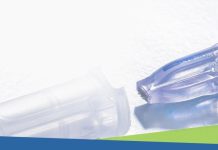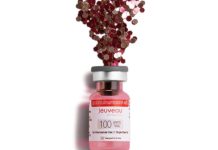A temporary breast enhancement using saline injections is gaining popularity. We asked the experts to give us the facts on the safety and potential risks.
You may have heard about the non-invasive, temporary breast augmentation that uses saline injections to create a day-long natural breast enhancement. Most recently, Playboy model and adult film actress Kayla Kayden shared that she has spent thousands of dollars to repeatedly inject her breasts with saline rather than get a second conventional breast augmentation.
She and many who get this procedure say it’s a great way to enhance the breast in a way that looks and feels natural. But is this procedure as safe as it seems? We investigate.
What Is a 24-Hour Boob Job?
The procedure was coined and developed by New York plastic surgeon Norman M. Rowe, MD as a way for his patients to “test drive” a conventional breast augmentation.
Glen Carbon, IL plastic surgeon Ryan Diederich, MD explains that the temporary breast enhancement is a simple injection of saline directly into the breast tissue. “This procedure involves injecting saline solution into the breasts to temporarily increase their size and volume,” Dr. Diederich explains. “The saline is injected into the breast tissue through a needle, and the amount of saline injected can be adjusted to achieve the desired level of enhancement.”
When saline is injected, it is slowly absorbed and eliminated by the body.
“Once saline solution is injected into the breast tissue during temporary breast augmentation, it is absorbed by the body and eliminated through the urinary system,” Dr. Diederich says. “The saline solution is similar to the fluid found in the body and is considered safe for injection in small amounts.”
Before it is absorbed by the body, the fluid expands the breast tissue to make them larger.
“The body naturally absorbs and eliminates the saline solution over time, typically within 24 to 48 hours,” Dr. Diederich says. “As the saline solution is absorbed, the breasts will gradually return to their original size and shape. The temporary nature of the procedure means that the results are not permanent and additional treatments would be required to maintain the enhanced appearance of the breasts.”
According to New York plastic surgeon Elie Levine, MD, this procedure appeals to people who either want a temporary enhancement for a specific event or who want to try out breast augmentation without the commitment.
“If someone got it done at 9 a.m. and they had an event that evening and wanted to look augmented, then I think it would be great for that, but I wouldn’t expect it to last until the next morning,” Dr. Levine explains.
What Are the Risks?
According to Dr. Levine, we do know that the saline solution itself is safe to be injected into the breast tissue. “It’s totally safe, not a big deal at all. There’s no real long-term downside to injecting saline into the body,” Dr. Levine says.
Dr. Diederich explains that while the procedure is considered safe, it’s important to inform patients of the potential risk. “Temporary breast augmentation with saline is generally considered safe; however, as with any medical procedure, there are potential risks and complications associated with the procedure,” Dr. Diederich says. “Some of the potential risks and complications include infection, bleeding, allergic reaction, asymmetry, changes in nipple sensation, and the formation of lumps or bumps in the breast tissue.”
Injections like this do have a chance of hitting a blood vessel, as well. According to Chicago plastic surgeon Julius Few, MD, the resulting hematoma can be unsightly and even dangerous. “When you’re putting in large volumes of saline, you do have the risk of hitting a blood vessel. And when you hit a blood vessel you get what’s called a hematoma which can cause tissue necrosis or tissue death,” Dr. Few explains. “You can end up with a situation where you could be left with what is basically a deformity.”
Most hematomas eventually dissolve, like a fading bruise from an IV needle. But some can continue to grow and eventually need to be surgically removed. If that happens on the hand or arm, where you might typically get an IV, that’s one thing. But on the breast, this could be particularly distressing.
“Even one time, if you get a hematoma, you could have a permanent deformity,” Dr. Few stresses. “There’s also a real risk of causing an infection.”
That’s because, in some women, the milk ducts within the breast have colonized good bacteria within them. “When you add saline to the breast, you could potentially unleash those bacteria into the rest of the breast tissue,” Dr. Few says. “The milk ducts are designed to handle those bacteria, the rest of the breast tissue is not.”
Are Saline Injections Safer Than Implants?
Well, that’s not really the right question.
According to Dr. Diederich, a traditional breast implant comes with greater risks than a saline injection, but the procedures are so different it’s hard to compare the two. “Traditional breast augmentation with implants is a surgical procedure that involves the insertion of breast implants to increase breast size, improve breast shape, or restore breast volume,” he explains. “The procedure is more invasive than temporary breast augmentation with saline and carries a higher risk of complications such as infection, bleeding, implant rupture, capsular contracture, and changes in nipple sensation.
“While it carries fewer risks than traditional breast augmentation with implants, it’s important to note that the results are temporary and may not be satisfactory for all patients.”
One also isn’t a substitute for the other.
A traditional breast augmentation provides nearly permanent results in a single procedure. A saline injection may not even last a full 24 hours.
“When you inject saline or fluid into any area, like during a liposuction procedure, you do see the effect immediately,” Dr. Levine explains. “And it does take around 24 hours, I’d say, for it to be absorbed back into your body. But that’s ballpark. It could be 7-8 hours or 30 hours, but it does begin to go away very quickly.”
Are There Other Concerns?
One of the reasons Kayden’s story stuck out so much was her commitment to repeating this procedure multiple times over the course of the year. Obviously, this isn’t practical for most women.
“The real downside to it is that it’s not inexpensive to do and it only lasts about 24 hours,” Dr. Levine explains. “It’s just not a viable long-term solution for regular patients. The only real value would be to try it once to see if a breast augmentation would work for you.”
Repeating the procedure like Kayden could have its own set of unintended consequences.
“The skin really isn’t meant to stretch and contract like that,” Dr. Few says. “Just like when a woman has multiple children, the skin can be stretched so much that it can’t pull itself back into its previous shape.”
Additionally, that repeated stretching and shrinking of skin could lead to texture changes. “With chronic tissue expansion and shrinking, the tendency is for the tissue to become woody or firm because of that repeated expansion, then shrink, expansion, then shrink,” Dr. Few explains. “That can create an unnatural texture or feel to the skin.”
There’s also the fact that patients of color may be more likely to experience hyperpigmentation as a result of a saline breast augmentation. “This procedure does stimulate inflammation, because the tissue is not meant to contract and expand like that,” Dr. Few explains. “So, in patients of color, you can get a situation where the skin becomes hyperpigmented or dyspigmented as a result.”
The Takeaway
According to Dr. Diederich, the idea of a temporary breast augmentation could easily appeal to patients. “Temporary breast augmentation is a personal choice depending on the patient’s goals,” he explains. “Temporary breast augmentation may provide a patient with their goals for an event or allow them to determine if they want a more permanent solution.”
Dr. Levine agrees that while not practical for repeated use, there are ways a temporary breast augmentation could benefit a patient. “I think if someone wants to, say, fill out their wedding dress without a breast augmentation or maybe they don’t have the downtime for that, then this could be an option.”
But according to Dr. Few, the temporary benefit just isn’t worth the risk.
“I would not recommend it even once,” Dr. Few says. “I just think the risk is too serious. If you get a hematoma, you could be left with a permanent deformity.”






